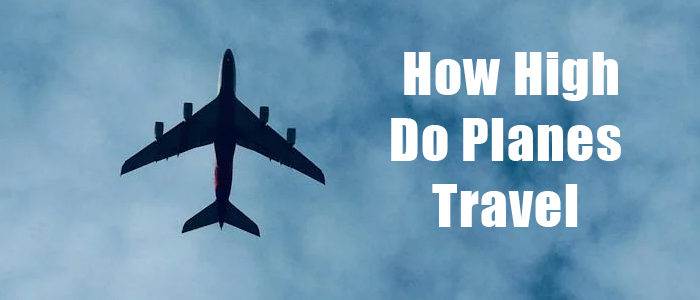Introduction
Planes, or more specifically airplanes, are designed to take off at a great height in order to gain maximum fuel efficiency and enhance the comfort and security of passengers. The normal cruising altitudes vary with the type of aircraft involved, the nature of the flight, and the airspace traversed.
The aspects of how high the planes travel and why they must travel at such altitudes as well as the influence exerted on their cruising heights will be understood in this work.
Commercial Flights Typical Altitudes
Most commercial planes fly at 30,000 to 40,000 feet of altitude above sea level. It is considered the height with maximum fuel economy with optimal efficiency of the engine, as it avoids turbulence within the weather system. Commercial jets like the Boeing 737 or Airbus A320 cruise at around 35,000 feet (10,668 meters). For the most part, long-haul flights with big jets - like the Boeing 777 or Airbus A380 - fly a little higher and usually top out around 40,000 feet.
Why They Fly High
There are a few reasons that aeroplanes fly so high:
-
Fuel Efficiency: With fewer air particles at higher altitudes, there are fewer drags on an aircraft. It travels faster with less fuel consumption which ensures long-haul travel becomes more efficient. Airlines save on operational costs that affect ticket prices and profitability.
-
Engine Efficiency: Jet engines optimize at high altitudes. Less dense air contributes less drag, and hence, better thrust with less energy, whereas in those engines efficiencies cut drastically at lower, denser altitudes.
-
Passenger Comfort: Flying at a higher altitude can be smoother because of reduced turbulence. Additionally, the feeling of acceleration and deceleration, which may come at lesser altitudes, becomes much less because of the higher altitude flown. Passengers will feel relatively comfortable, especially for long-distance flights.
Altitude Variations According to Type of Flights
Different aircraft types and flight types entail different altitudes:
-
Short-haul Flights: These flights, that cover less than 1,000 nautical miles or approximately travel distances less than 1,000 miles, cruise up to altitudes as low as 25,000 and 30,000 feet because the flight is simply too short. Because there isn't enough time for the plane to reach cruising altitude high enough and then later descend to land after all that time, it follows that these planes just stay at lower altitudes.
-
Long-haul Flights: For missions that exceed 1,500 miles in distance, long-haul flights apply. Such flights often cruise at altitudes of 35,000 to 40,000 feet. They cruise that high because they spend a significant amount of their time airborne, and cruising at this height is the most fuel-efficient for long durations spent in the air.
-
Private and Business Jets: Due to their more modest size, jets can often fly at greater altitudes compared to commercial flights, sometimes up to 41,000 to 45,000 feet. Fewer passengers, a smaller airframe, and an increased rate of climb and ascent leave more time to avoid commercial air traffic in, for example, the final climb portion, and often at higher altitudes flying conditions become smoother.
Conditions that Influence Altitude Flying
There are a number of considerations that determine how high an airplane may be flown or it is wise to fly:
-
Weight of Aircraft: The heavier the aircraft, it may not move to higher altitudes, especially after leaving the ground or after cargo as well as passengers have been transported on board. When the aircraft consumes fuel during flight, it becomes lighter and might move to a higher altitude.
-
Air Traffic Control (ATC): Such elements of the ATC ensure proper separation of aircraft to avoid collision. Depending on the level of congestion in the airspace, aircraft may need to fly at lower or higher altitudes than initially anticipated.
-
Weather: Raging storms can force aircraft to fly at different altitudes compared to what is planned. For instance, pilots may request flying at a lower cruising altitude to avoid severe turbulence or a more powerful headwind.
-
Flight Distance: Distances that are longer undertake cruising over higher altitudes, simply because they have more time to make up for less fuel consumption. For small distances, it would be a more practical decision to cruise at lower altitudes since climbing up to a higher altitude would make the flight impractically short.
Layers and Limits of Airspace
Planes fly in the troposphere, a layer that goes from the ground up to about 36,000 feet. Above that is the stratosphere where commercial jets start to feel much less turbulence. There's hardly ever a reason to go up to above 40,000 feet as oxygen is too thin to sustain human life without pressurization, and engine performance degrades.
Some military aircraft and high-altitude reconnaissance planes can reach 70,000 feet and higher. Commercial aviation stays safely within the range of 30,000 to 40,000 feet.
Conclusion
Planes travel at altitudes between 30,000 to 40,000 feet to get the best fuel efficiency and avoid various systems of weather since engines perform much better at certain heights. The altitude flown by a plane is a direct result of the weight during flight distance and air traffic. Going high means that, besides getting a more efficient, smooth, and comfortable traveling experience for the passengers, they are actually saving on fuel and reducing travel time.

